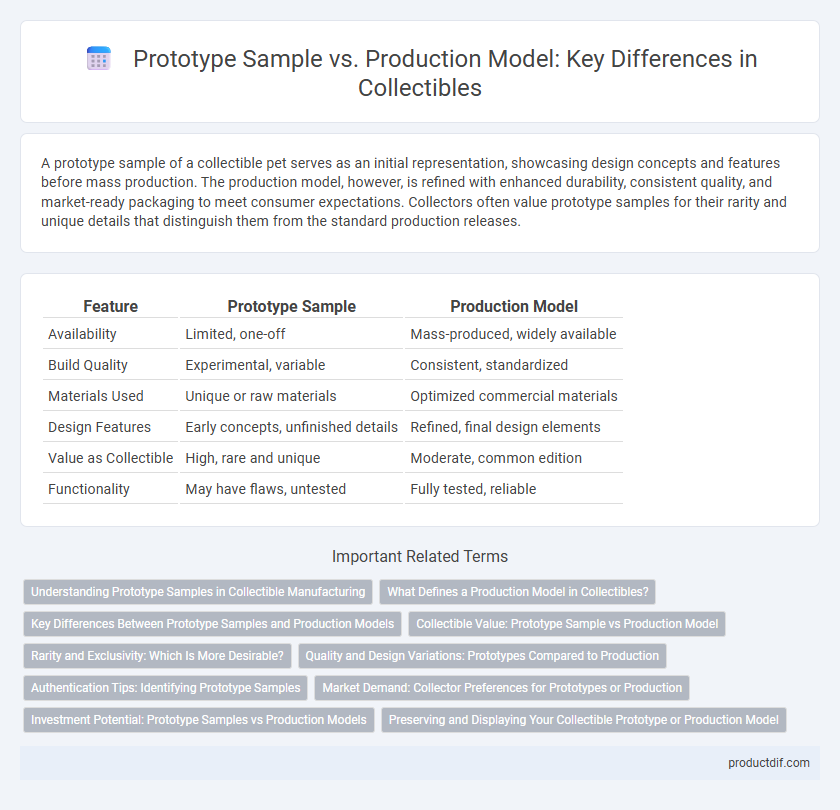A prototype sample of a collectible pet serves as an initial representation, showcasing design concepts and features before mass production. The production model, however, is refined with enhanced durability, consistent quality, and market-ready packaging to meet consumer expectations. Collectors often value prototype samples for their rarity and unique details that distinguish them from the standard production releases.
Table of Comparison
| Feature | Prototype Sample | Production Model |
|---|---|---|
| Availability | Limited, one-off | Mass-produced, widely available |
| Build Quality | Experimental, variable | Consistent, standardized |
| Materials Used | Unique or raw materials | Optimized commercial materials |
| Design Features | Early concepts, unfinished details | Refined, final design elements |
| Value as Collectible | High, rare and unique | Moderate, common edition |
| Functionality | May have flaws, untested | Fully tested, reliable |
Understanding Prototype Samples in Collectible Manufacturing
Prototype samples serve as the initial physical representations of collectible items, designed to test form, function, and aesthetic appeal before mass production. These prototypes often feature unique details or variations that differ from the finalized production models, making them highly sought after by collectors due to their rarity and insight into the manufacturing process. Understanding the distinctions between prototype samples and production models is essential for evaluating authenticity, value, and historical significance in the collectible market.
What Defines a Production Model in Collectibles?
A production model in collectibles is characterized by its large-scale manufacturing and consistent quality control, ensuring uniformity across all units. Unlike prototype samples, production models are the finalized versions released to the market, often featuring complete packaging, official branding, and compliance with regulatory standards. Collectors value production models for their authenticity, availability, and official status within a collectible series.
Key Differences Between Prototype Samples and Production Models
Prototype samples serve as initial physical versions used to test design concepts, functionality, and materials, often featuring hand-crafted elements or limited finishes. Production models are finalized, mass-produced items that adhere to strict quality standards, uniformity, and durability for consistent consumer distribution. Key differences lie in detail refinement, manufacturing processes, and overall quality control, with prototypes showcasing experimental features absent in production models.
Collectible Value: Prototype Sample vs Production Model
Prototype samples often hold greater collectible value due to their rarity and unique design features that differ from mass-produced production models. Limited to only a few units, prototypes provide insight into the development process and showcase variations not found in final versions. Collectors prioritize prototype samples for their exclusivity and historical significance within the collectible market.
Rarity and Exclusivity: Which Is More Desirable?
Prototype samples in collectibles are often more desirable due to their extreme rarity and unique design features that never reach mass production, making them highly exclusive. Production models, while still valuable, are generally less rare as they are manufactured in larger quantities, reducing their scarcity. Collectors prioritize prototype samples for their distinctiveness and limited availability, which significantly enhances their investment appeal.
Quality and Design Variations: Prototypes Compared to Production
Prototype samples showcase early design concepts and often feature hand-crafted details, resulting in unique imperfections and experimental materials that are not present in production models. Production models benefit from refined manufacturing processes, ensuring consistent quality, tighter tolerances, and standardized components that improve durability and functionality. Collectors highly value prototype samples for their rarity and insight into the design evolution, while production models are prized for their polished finish and reliability.
Authentication Tips: Identifying Prototype Samples
Prototype samples often feature unique manufacturing marks, different serial numbers, or unfinished details compared to production models; closely examining these elements can authenticate a collectible. Authentication tips include inspecting irregular paint applications, inconsistent logos, and variations in material quality that prototypes typically exhibit. Cross-referencing prototype attributes with official company archives or expert databases enhances verification accuracy.
Market Demand: Collector Preferences for Prototypes or Production
Collector preferences for prototypes often center on the rarity and uniqueness that prototypes offer compared to production models. Market demand tends to favor production models for their polished design and wider recognition, yet prototypes can command premium prices due to their limited availability and historical significance. The choice between prototype samples and production models reflects a collector's priority on exclusivity versus mainstream appeal within the collectible market.
Investment Potential: Prototype Samples vs Production Models
Prototype samples hold unique investment potential due to their rarity and exclusive features, often commanding higher value among collectors compared to production models. Production models benefit from broader market availability but typically have lower appreciation rates and resale values. Investors prioritize prototype samples for their scarcity and historical significance, which drive long-term collectible worth.
Preserving and Displaying Your Collectible Prototype or Production Model
Prototype samples often feature unique design elements and limited production, making them highly valuable collectibles requiring careful preservation using acid-free materials and controlled environments to prevent deterioration. Production models, while more common, still hold significant collector interest and benefit from display cases with UV protection to maintain paint and material integrity. Both prototype samples and production models should be showcased with detailed documentation and provenance to enhance their collectible value and historical significance.
Prototype Sample vs Production Model Infographic

 productdif.com
productdif.com